Statistical Concepts and Applications Assignment - Semester 1
VerifiedAdded on 2023/06/08
|20
|3282
|118
Homework Assignment
AI Summary
This document presents a comprehensive solution to a statistics assignment focusing on mathematical concepts and statistical applications. The assignment covers several key areas, including normal distribution, sampling distributions, the central limit theorem, binomial distributions, and the normal approximation to binomial distributions. The solution provides step-by-step calculations and explanations for problems related to the height of females, gestation periods, calorie intake of males, oil changes, and fishing catch rates. It also addresses problems related to new product failures in grocery stores. The solutions utilize Z-scores, probability calculations, and continuity correction factors to arrive at the final answers. The document demonstrates the application of statistical concepts to real-world scenarios and provides a detailed analysis of each problem.

Mathematical Concepts and Statistical Applications
Mathematics Application
Student Name
Institution Affiliation
Mathematics Application
Student Name
Institution Affiliation
Paraphrase This Document
Need a fresh take? Get an instant paraphrase of this document with our AI Paraphraser
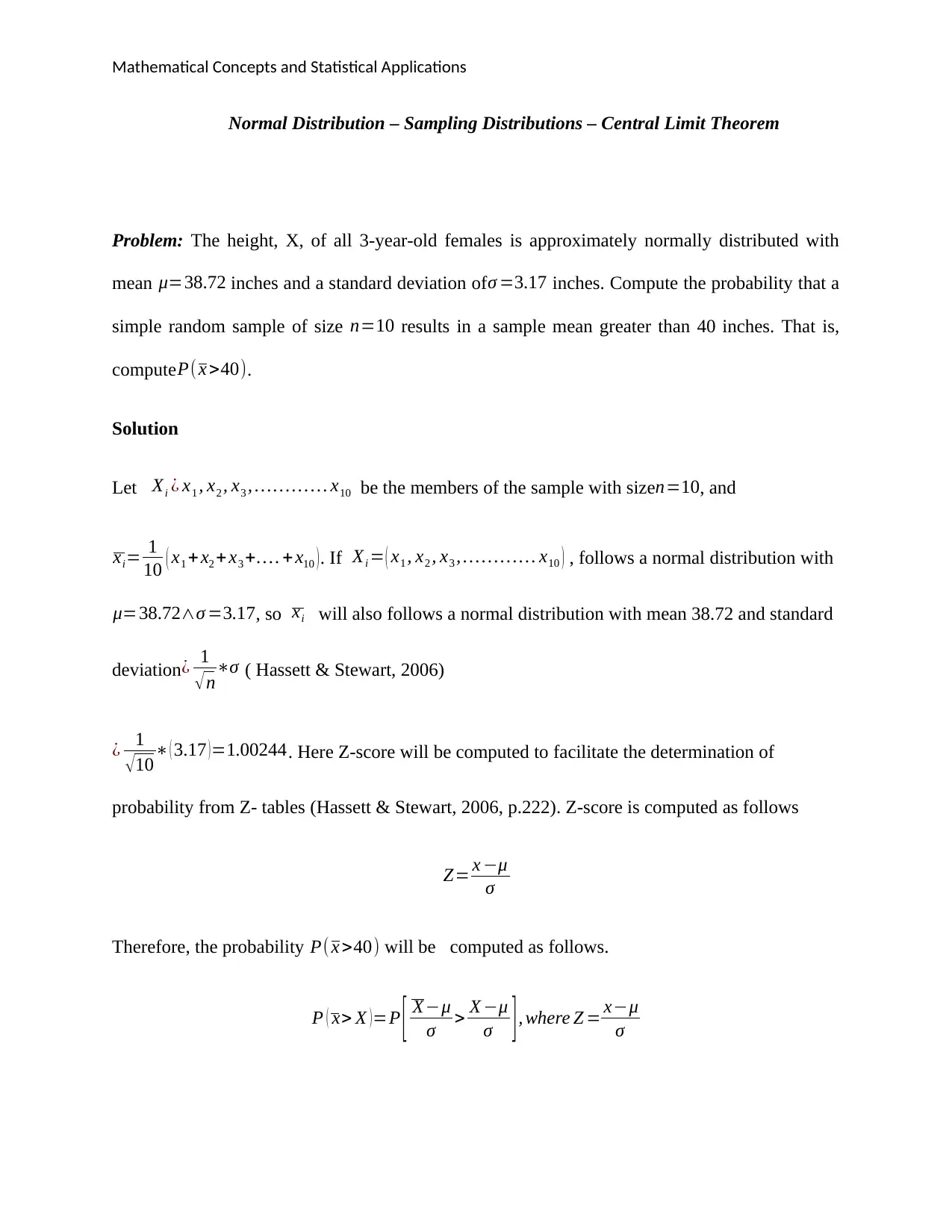
Mathematical Concepts and Statistical Applications
Normal Distribution – Sampling Distributions – Central Limit Theorem
Problem: The height, X, of all 3-year-old females is approximately normally distributed with
mean μ=38.72 inches and a standard deviation of σ =3.17 inches. Compute the probability that a
simple random sample of size n=10 results in a sample mean greater than 40 inches. That is,
computeP( x >40).
Solution
Let Xi ¿ x1 , x2 , x3 , …… … … x10 be the members of the sample with size n=10, and
xi= 1
10 ( x1 +x2 +x3 +… . + x10 ). If Xi = ( x1 , x2 , x3 , … … … … x10 ) , follows a normal distribution with
μ=38.72∧σ =3.17, so xi will also follows a normal distribution with mean 38.72 and standard
deviation¿ 1
√n∗σ ( Hassett & Stewart, 2006)
¿ 1
√ 10∗ ( 3.17 ) =1.00244. Here Z-score will be computed to facilitate the determination of
probability from Z- tables (Hassett & Stewart, 2006, p.222). Z-score is computed as follows
Z= x −μ
σ
Therefore, the probability P( x >40) will be computed as follows.
P ( x> X ) =P [ X−μ
σ > X −μ
σ ] , where Z = x−μ
σ
Normal Distribution – Sampling Distributions – Central Limit Theorem
Problem: The height, X, of all 3-year-old females is approximately normally distributed with
mean μ=38.72 inches and a standard deviation of σ =3.17 inches. Compute the probability that a
simple random sample of size n=10 results in a sample mean greater than 40 inches. That is,
computeP( x >40).
Solution
Let Xi ¿ x1 , x2 , x3 , …… … … x10 be the members of the sample with size n=10, and
xi= 1
10 ( x1 +x2 +x3 +… . + x10 ). If Xi = ( x1 , x2 , x3 , … … … … x10 ) , follows a normal distribution with
μ=38.72∧σ =3.17, so xi will also follows a normal distribution with mean 38.72 and standard
deviation¿ 1
√n∗σ ( Hassett & Stewart, 2006)
¿ 1
√ 10∗ ( 3.17 ) =1.00244. Here Z-score will be computed to facilitate the determination of
probability from Z- tables (Hassett & Stewart, 2006, p.222). Z-score is computed as follows
Z= x −μ
σ
Therefore, the probability P( x >40) will be computed as follows.
P ( x> X ) =P [ X−μ
σ > X −μ
σ ] , where Z = x−μ
σ
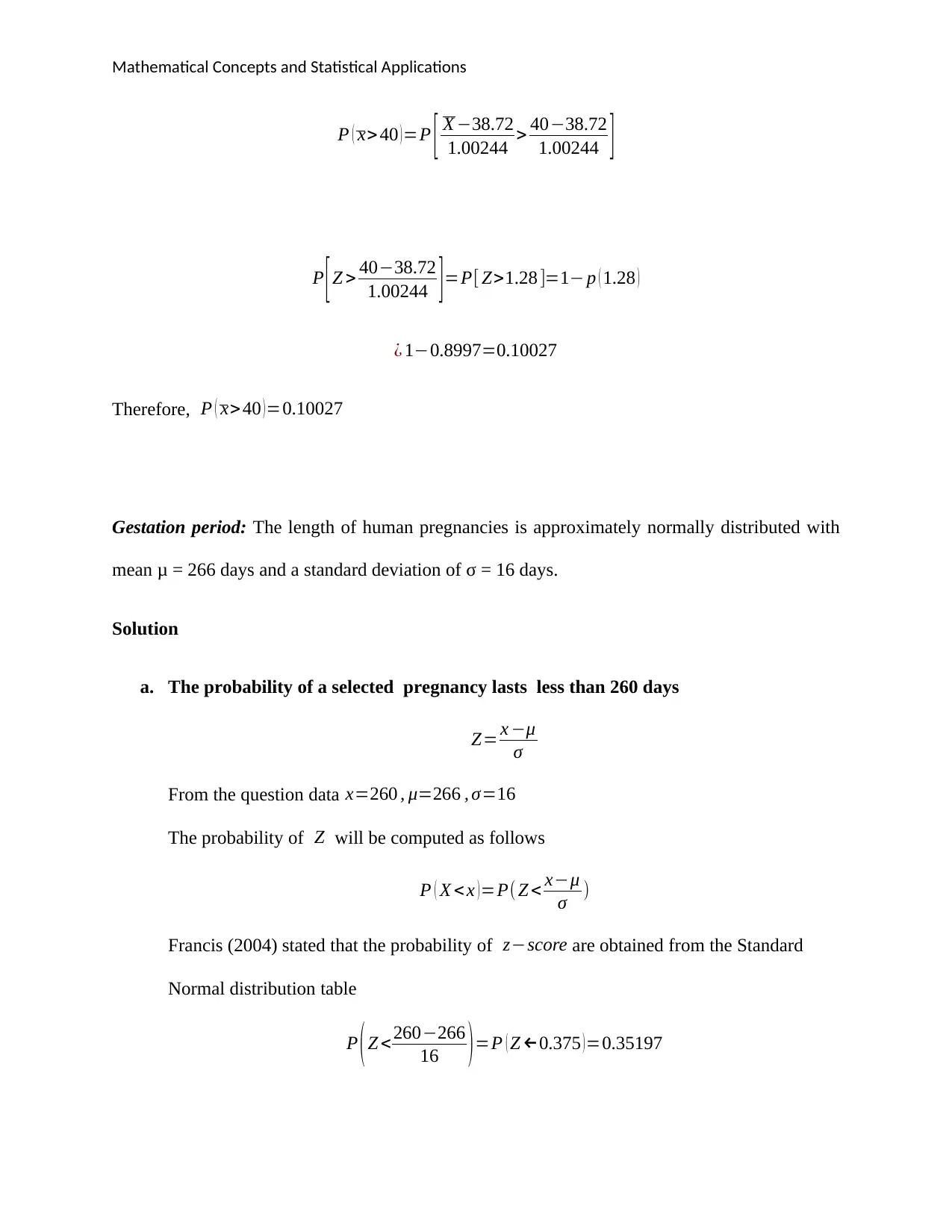
Mathematical Concepts and Statistical Applications
P ( x>40 )=P [ X −38.72
1.00244 > 40−38.72
1.00244 ]
P [Z > 40−38.72
1.00244 ]=P[ Z>1.28 ]=1− p ( 1.28 )
¿ 1−0.8997=0.10027
Therefore, P ( x>40 )=0.10027
Gestation period: The length of human pregnancies is approximately normally distributed with
mean μ = 266 days and a standard deviation of σ = 16 days.
Solution
a. The probability of a selected pregnancy lasts less than 260 days
Z= x −μ
σ
From the question data x=260 , μ=266 , σ=16
The probability of Z will be computed as follows
P ( X < x )=P( Z < x−μ
σ )
Francis (2004) stated that the probability of z−score are obtained from the Standard
Normal distribution table
P (Z < 260−266
16 )=P ( Z ←0.375 )=0.35197
P ( x>40 )=P [ X −38.72
1.00244 > 40−38.72
1.00244 ]
P [Z > 40−38.72
1.00244 ]=P[ Z>1.28 ]=1− p ( 1.28 )
¿ 1−0.8997=0.10027
Therefore, P ( x>40 )=0.10027
Gestation period: The length of human pregnancies is approximately normally distributed with
mean μ = 266 days and a standard deviation of σ = 16 days.
Solution
a. The probability of a selected pregnancy lasts less than 260 days
Z= x −μ
σ
From the question data x=260 , μ=266 , σ=16
The probability of Z will be computed as follows
P ( X < x )=P( Z < x−μ
σ )
Francis (2004) stated that the probability of z−score are obtained from the Standard
Normal distribution table
P (Z < 260−266
16 )=P ( Z ←0.375 )=0.35197
⊘ This is a preview!⊘
Do you want full access?
Subscribe today to unlock all pages.

Trusted by 1+ million students worldwide
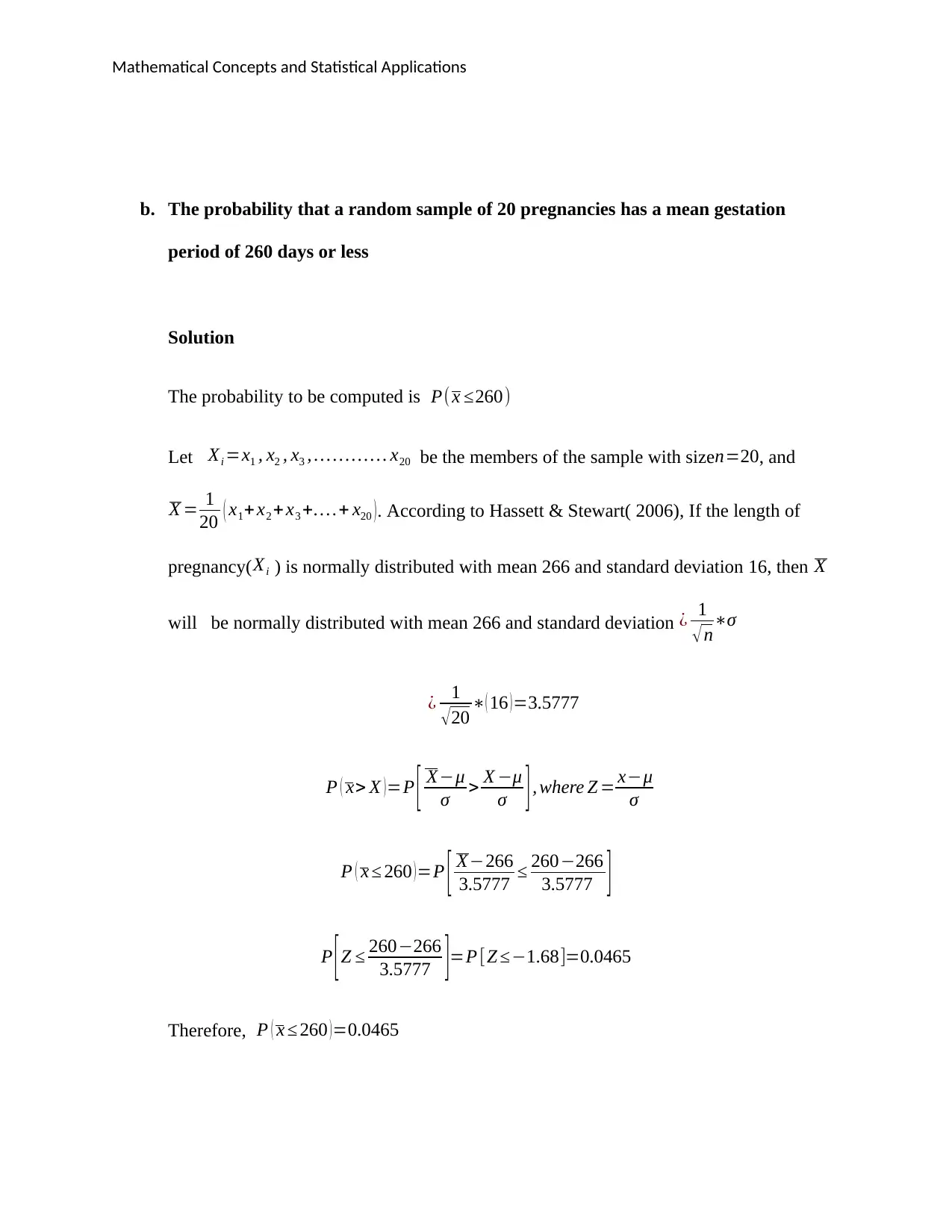
Mathematical Concepts and Statistical Applications
b. The probability that a random sample of 20 pregnancies has a mean gestation
period of 260 days or less
Solution
The probability to be computed is P( x ≤260)
Let Xi =x1 , x2 , x3 , … … … … x20 be the members of the sample with sizen=20, and
X = 1
20 ( x1+ x2 + x3 +… .+ x20 ). According to Hassett & Stewart( 2006), If the length of
pregnancy(Xi ) is normally distributed with mean 266 and standard deviation 16, then X
will be normally distributed with mean 266 and standard deviation ¿ 1
√ n∗σ
¿ 1
√ 20 ∗( 16 ) =3.5777
P ( x> X ) =P [ X−μ
σ > X −μ
σ ] , where Z = x−μ
σ
P ( x ≤ 260 )=P [ X−266
3.5777 ≤ 260−266
3.5777 ]
P [ Z ≤ 260−266
3.5777 ]=P [Z ≤−1.68]=0.0465
Therefore, P ( x ≤ 260 ) =0.0465
b. The probability that a random sample of 20 pregnancies has a mean gestation
period of 260 days or less
Solution
The probability to be computed is P( x ≤260)
Let Xi =x1 , x2 , x3 , … … … … x20 be the members of the sample with sizen=20, and
X = 1
20 ( x1+ x2 + x3 +… .+ x20 ). According to Hassett & Stewart( 2006), If the length of
pregnancy(Xi ) is normally distributed with mean 266 and standard deviation 16, then X
will be normally distributed with mean 266 and standard deviation ¿ 1
√ n∗σ
¿ 1
√ 20 ∗( 16 ) =3.5777
P ( x> X ) =P [ X−μ
σ > X −μ
σ ] , where Z = x−μ
σ
P ( x ≤ 260 )=P [ X−266
3.5777 ≤ 260−266
3.5777 ]
P [ Z ≤ 260−266
3.5777 ]=P [Z ≤−1.68]=0.0465
Therefore, P ( x ≤ 260 ) =0.0465
Paraphrase This Document
Need a fresh take? Get an instant paraphrase of this document with our AI Paraphraser
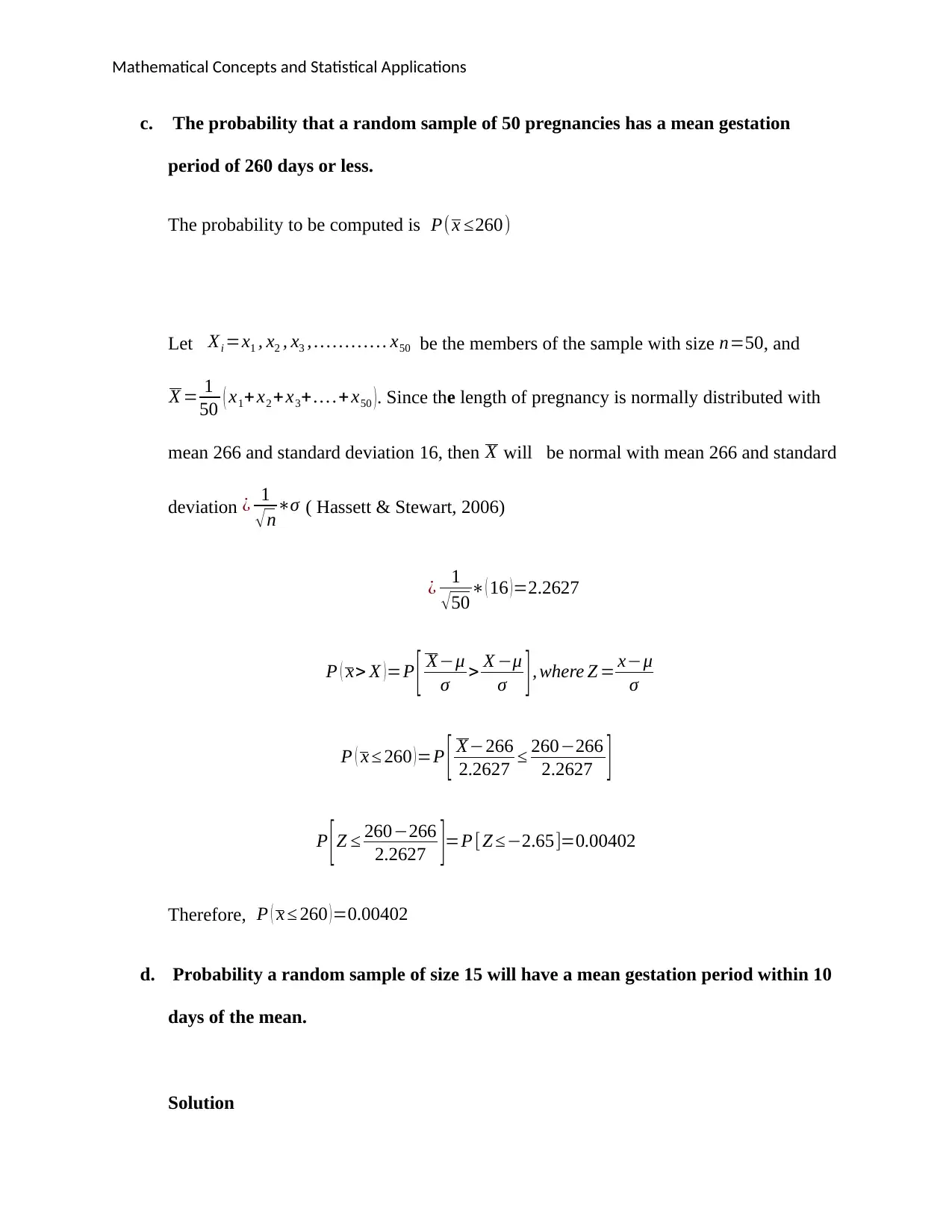
Mathematical Concepts and Statistical Applications
c. The probability that a random sample of 50 pregnancies has a mean gestation
period of 260 days or less.
The probability to be computed is P( x ≤260)
Let Xi =x1 , x2 , x3 , … … … … x50 be the members of the sample with size n=50, and
X = 1
50 ( x1+x2 + x3+ … .+ x50 ). Since the length of pregnancy is normally distributed with
mean 266 and standard deviation 16, then X will be normal with mean 266 and standard
deviation ¿ 1
√n∗σ ( Hassett & Stewart, 2006)
¿ 1
√50∗ ( 16 )=2.2627
P ( x> X ) =P [ X−μ
σ > X −μ
σ ] , where Z = x−μ
σ
P ( x ≤ 260 ) =P [ X−266
2.2627 ≤ 260−266
2.2627 ]
P [ Z ≤ 260−266
2.2627 ]=P [ Z ≤−2.65]=0.00402
Therefore, P ( x ≤ 260 )=0.00402
d. Probability a random sample of size 15 will have a mean gestation period within 10
days of the mean.
Solution
c. The probability that a random sample of 50 pregnancies has a mean gestation
period of 260 days or less.
The probability to be computed is P( x ≤260)
Let Xi =x1 , x2 , x3 , … … … … x50 be the members of the sample with size n=50, and
X = 1
50 ( x1+x2 + x3+ … .+ x50 ). Since the length of pregnancy is normally distributed with
mean 266 and standard deviation 16, then X will be normal with mean 266 and standard
deviation ¿ 1
√n∗σ ( Hassett & Stewart, 2006)
¿ 1
√50∗ ( 16 )=2.2627
P ( x> X ) =P [ X−μ
σ > X −μ
σ ] , where Z = x−μ
σ
P ( x ≤ 260 ) =P [ X−266
2.2627 ≤ 260−266
2.2627 ]
P [ Z ≤ 260−266
2.2627 ]=P [ Z ≤−2.65]=0.00402
Therefore, P ( x ≤ 260 )=0.00402
d. Probability a random sample of size 15 will have a mean gestation period within 10
days of the mean.
Solution
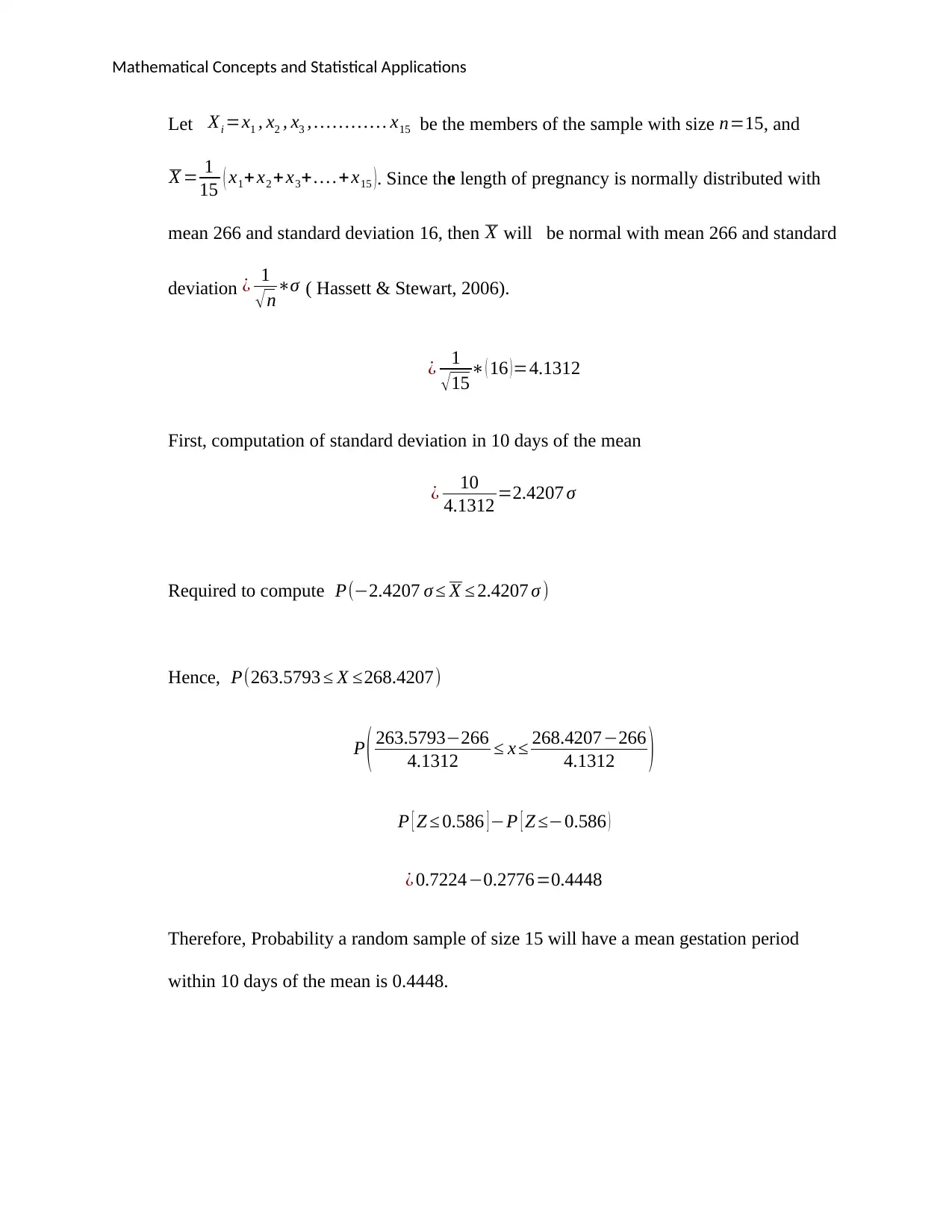
Mathematical Concepts and Statistical Applications
Let Xi =x1 , x2 , x3 , … … … … x15 be the members of the sample with size n=15, and
X = 1
15 ( x1+ x2 + x3+… .+x15 ). Since the length of pregnancy is normally distributed with
mean 266 and standard deviation 16, then X will be normal with mean 266 and standard
deviation ¿ 1
√n∗σ ( Hassett & Stewart, 2006).
¿ 1
√ 15∗ ( 16 ) =4.1312
First, computation of standard deviation in 10 days of the mean
¿ 10
4.1312 =2.4207 σ
Required to compute P(−2.4207 σ ≤ X ≤ 2.4207 σ )
Hence, P(263.5793 ≤ X ≤268.4207)
P ( 263.5793−266
4.1312 ≤ x ≤ 268.4207−266
4.1312 )
P [ Z ≤ 0.586 ] −P [ Z ≤−0.586 )
¿ 0.7224−0.2776=0.4448
Therefore, Probability a random sample of size 15 will have a mean gestation period
within 10 days of the mean is 0.4448.
Let Xi =x1 , x2 , x3 , … … … … x15 be the members of the sample with size n=15, and
X = 1
15 ( x1+ x2 + x3+… .+x15 ). Since the length of pregnancy is normally distributed with
mean 266 and standard deviation 16, then X will be normal with mean 266 and standard
deviation ¿ 1
√n∗σ ( Hassett & Stewart, 2006).
¿ 1
√ 15∗ ( 16 ) =4.1312
First, computation of standard deviation in 10 days of the mean
¿ 10
4.1312 =2.4207 σ
Required to compute P(−2.4207 σ ≤ X ≤ 2.4207 σ )
Hence, P(263.5793 ≤ X ≤268.4207)
P ( 263.5793−266
4.1312 ≤ x ≤ 268.4207−266
4.1312 )
P [ Z ≤ 0.586 ] −P [ Z ≤−0.586 )
¿ 0.7224−0.2776=0.4448
Therefore, Probability a random sample of size 15 will have a mean gestation period
within 10 days of the mean is 0.4448.
⊘ This is a preview!⊘
Do you want full access?
Subscribe today to unlock all pages.

Trusted by 1+ million students worldwide
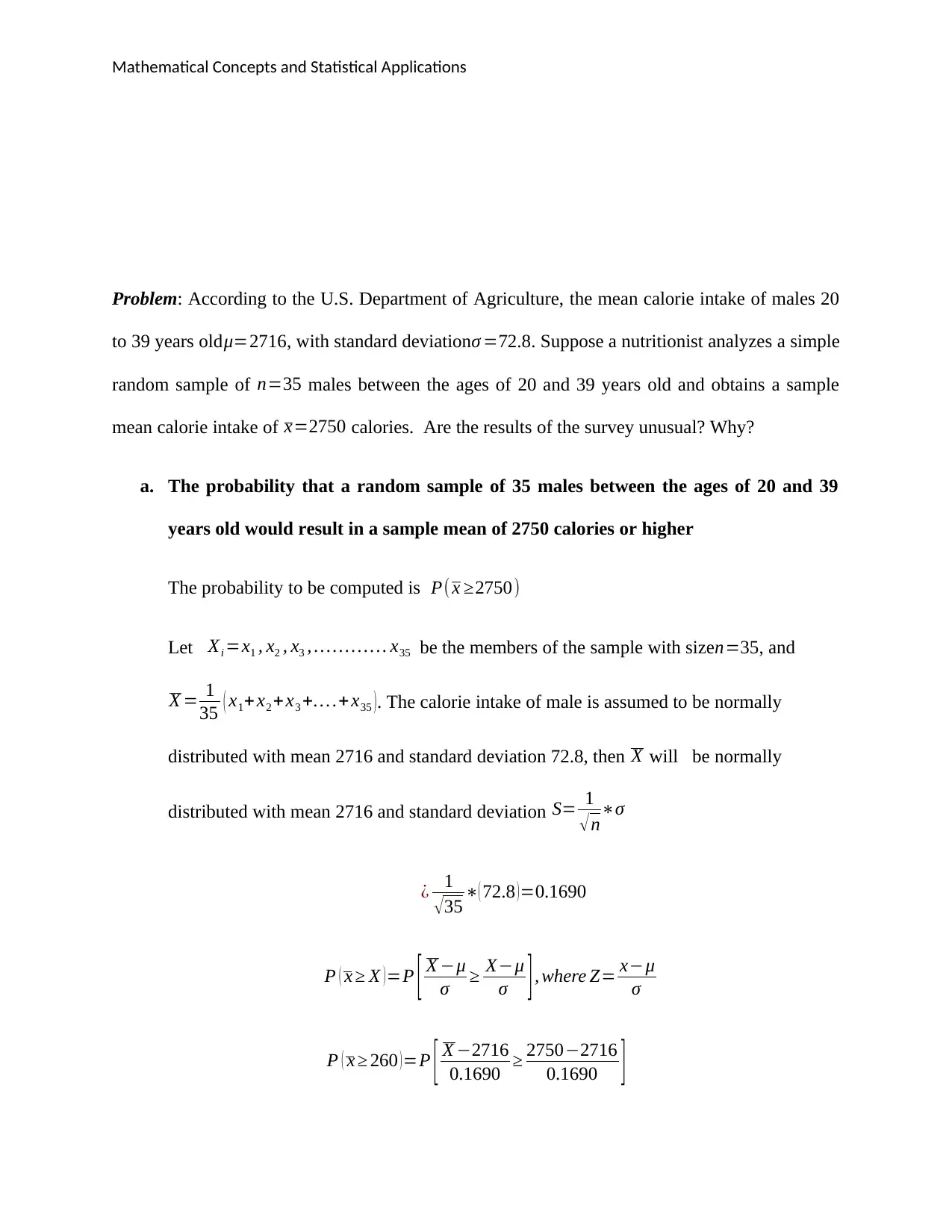
Mathematical Concepts and Statistical Applications
Problem: According to the U.S. Department of Agriculture, the mean calorie intake of males 20
to 39 years old μ=2716, with standard deviationσ =72.8. Suppose a nutritionist analyzes a simple
random sample of n=35 males between the ages of 20 and 39 years old and obtains a sample
mean calorie intake of x=2750 calories. Are the results of the survey unusual? Why?
a. The probability that a random sample of 35 males between the ages of 20 and 39
years old would result in a sample mean of 2750 calories or higher
The probability to be computed is P( x ≥2750)
Let Xi =x1 , x2 , x3 , … … … … x35 be the members of the sample with sizen=35, and
X = 1
35 ( x1+x2 + x3 +… .+ x35 ). The calorie intake of male is assumed to be normally
distributed with mean 2716 and standard deviation 72.8, then X will be normally
distributed with mean 2716 and standard deviation S= 1
√n∗σ
¿ 1
√35 ∗( 72.8 )=0.1690
P ( x ≥ X ) =P [ X −μ
σ ≥ X−μ
σ ] , where Z= x−μ
σ
P ( x ≥ 260 ) =P [ X −2716
0.1690 ≥ 2750−2716
0.1690 ]
Problem: According to the U.S. Department of Agriculture, the mean calorie intake of males 20
to 39 years old μ=2716, with standard deviationσ =72.8. Suppose a nutritionist analyzes a simple
random sample of n=35 males between the ages of 20 and 39 years old and obtains a sample
mean calorie intake of x=2750 calories. Are the results of the survey unusual? Why?
a. The probability that a random sample of 35 males between the ages of 20 and 39
years old would result in a sample mean of 2750 calories or higher
The probability to be computed is P( x ≥2750)
Let Xi =x1 , x2 , x3 , … … … … x35 be the members of the sample with sizen=35, and
X = 1
35 ( x1+x2 + x3 +… .+ x35 ). The calorie intake of male is assumed to be normally
distributed with mean 2716 and standard deviation 72.8, then X will be normally
distributed with mean 2716 and standard deviation S= 1
√n∗σ
¿ 1
√35 ∗( 72.8 )=0.1690
P ( x ≥ X ) =P [ X −μ
σ ≥ X−μ
σ ] , where Z= x−μ
σ
P ( x ≥ 260 ) =P [ X −2716
0.1690 ≥ 2750−2716
0.1690 ]
Paraphrase This Document
Need a fresh take? Get an instant paraphrase of this document with our AI Paraphraser
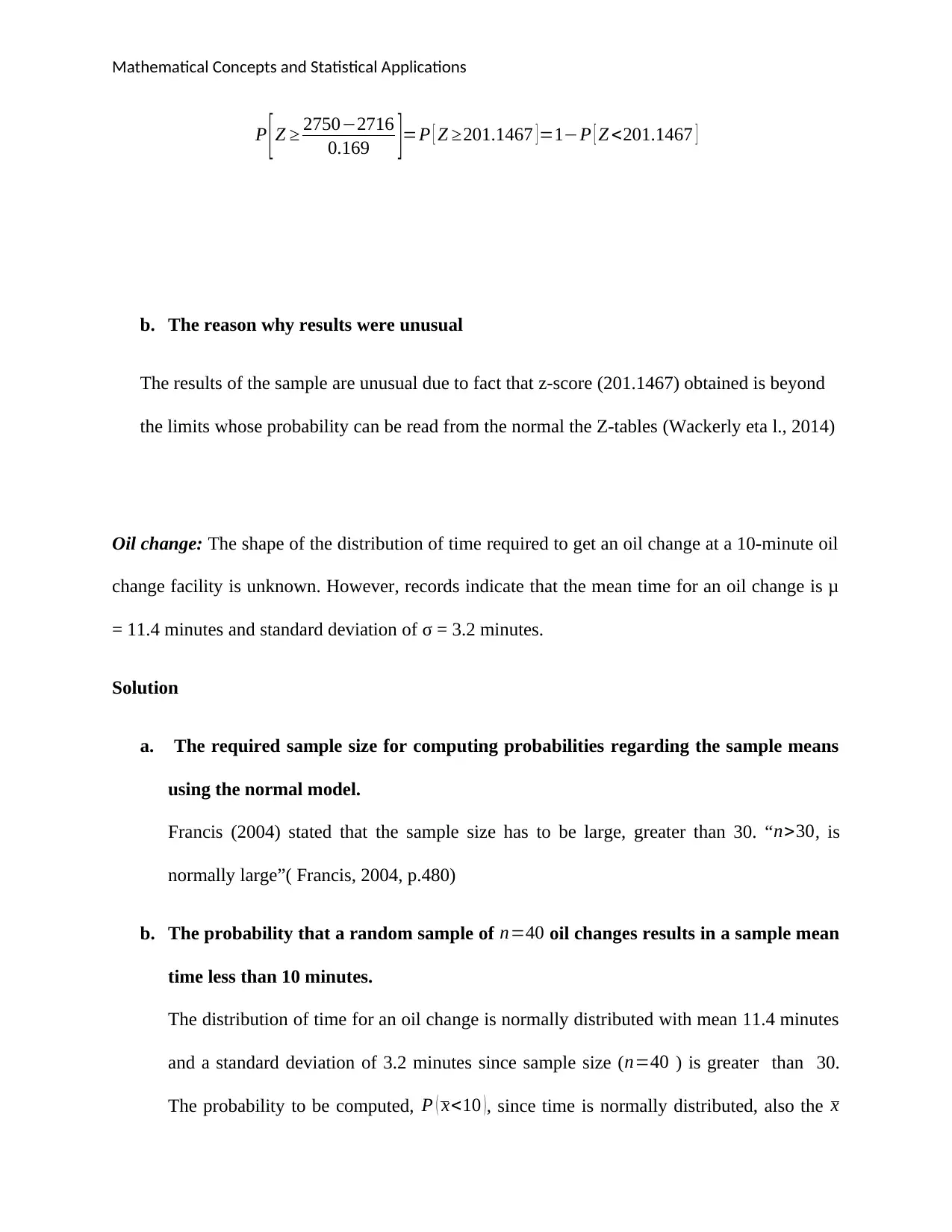
Mathematical Concepts and Statistical Applications
P [Z ≥ 2750−2716
0.169 ]=P [ Z ≥201.1467 ] =1−P [ Z <201.1467 ]
b. The reason why results were unusual
The results of the sample are unusual due to fact that z-score (201.1467) obtained is beyond
the limits whose probability can be read from the normal the Z-tables (Wackerly eta l., 2014)
Oil change: The shape of the distribution of time required to get an oil change at a 10-minute oil
change facility is unknown. However, records indicate that the mean time for an oil change is μ
= 11.4 minutes and standard deviation of σ = 3.2 minutes.
Solution
a. The required sample size for computing probabilities regarding the sample means
using the normal model.
Francis (2004) stated that the sample size has to be large, greater than 30. “n>30, is
normally large”( Francis, 2004, p.480)
b. The probability that a random sample of n=40 oil changes results in a sample mean
time less than 10 minutes.
The distribution of time for an oil change is normally distributed with mean 11.4 minutes
and a standard deviation of 3.2 minutes since sample size (n=40 ) is greater than 30.
The probability to be computed, P ( x<10 ), since time is normally distributed, also the x
P [Z ≥ 2750−2716
0.169 ]=P [ Z ≥201.1467 ] =1−P [ Z <201.1467 ]
b. The reason why results were unusual
The results of the sample are unusual due to fact that z-score (201.1467) obtained is beyond
the limits whose probability can be read from the normal the Z-tables (Wackerly eta l., 2014)
Oil change: The shape of the distribution of time required to get an oil change at a 10-minute oil
change facility is unknown. However, records indicate that the mean time for an oil change is μ
= 11.4 minutes and standard deviation of σ = 3.2 minutes.
Solution
a. The required sample size for computing probabilities regarding the sample means
using the normal model.
Francis (2004) stated that the sample size has to be large, greater than 30. “n>30, is
normally large”( Francis, 2004, p.480)
b. The probability that a random sample of n=40 oil changes results in a sample mean
time less than 10 minutes.
The distribution of time for an oil change is normally distributed with mean 11.4 minutes
and a standard deviation of 3.2 minutes since sample size (n=40 ) is greater than 30.
The probability to be computed, P ( x<10 ), since time is normally distributed, also the x

Mathematical Concepts and Statistical Applications
is normally distributed with mean 11.4 minutes and standard deviation ¿ 1
√n∗σ (Hassett
& Stewart, 2006)
¿ 1
√ 40∗( 3.2 ) =0.5590.
Therefore, P ( x<10 )=P [Z < 10−11.4
0.5590 ]
¿ P [ Z ←2.504 ] =0.0062
Therefore, P ( x<10 ) =0.0062
is normally distributed with mean 11.4 minutes and standard deviation ¿ 1
√n∗σ (Hassett
& Stewart, 2006)
¿ 1
√ 40∗( 3.2 ) =0.5590.
Therefore, P ( x<10 )=P [Z < 10−11.4
0.5590 ]
¿ P [ Z ←2.504 ] =0.0062
Therefore, P ( x<10 ) =0.0062
⊘ This is a preview!⊘
Do you want full access?
Subscribe today to unlock all pages.

Trusted by 1+ million students worldwide
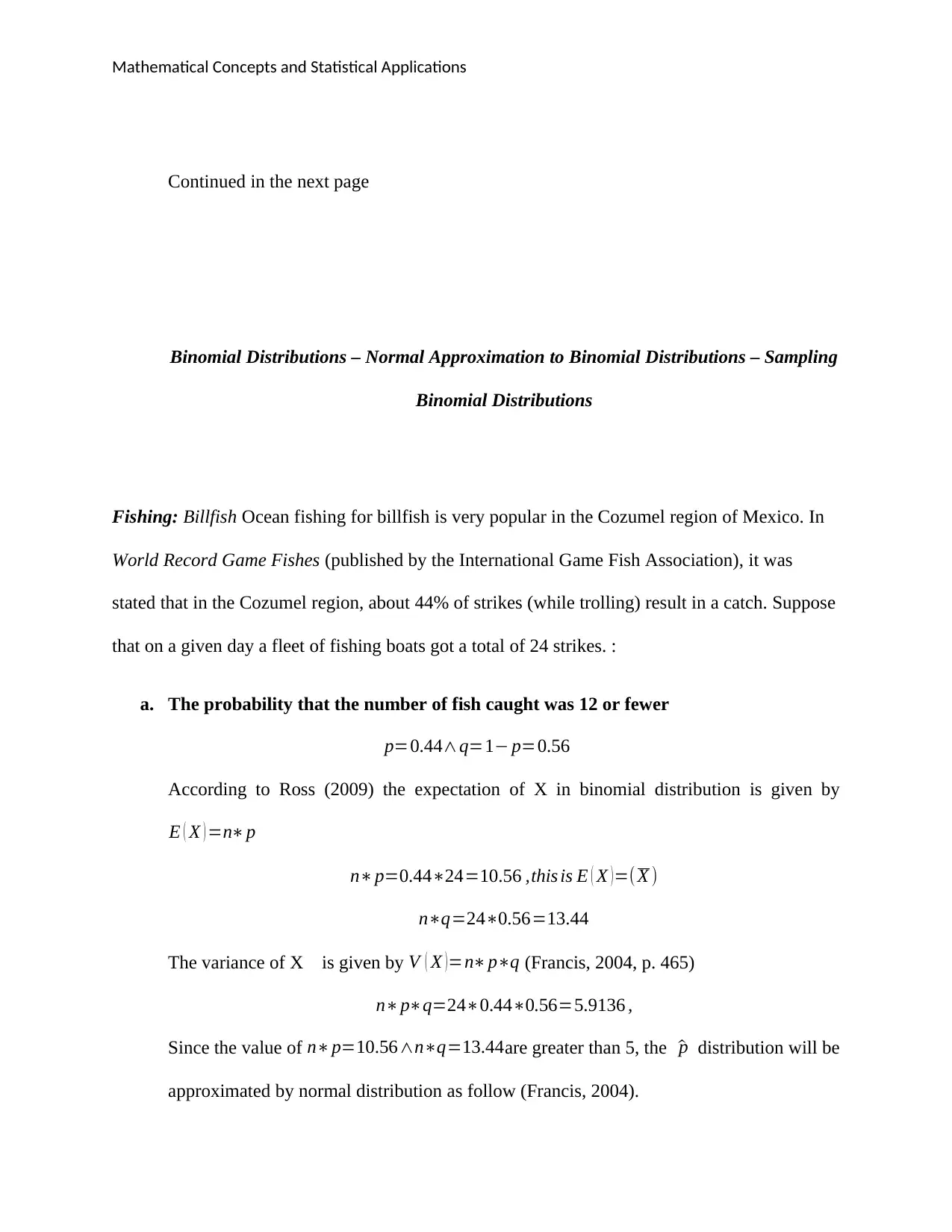
Mathematical Concepts and Statistical Applications
Continued in the next page
Binomial Distributions – Normal Approximation to Binomial Distributions – Sampling
Binomial Distributions
Fishing: Billfish Ocean fishing for billfish is very popular in the Cozumel region of Mexico. In
World Record Game Fishes (published by the International Game Fish Association), it was
stated that in the Cozumel region, about 44% of strikes (while trolling) result in a catch. Suppose
that on a given day a fleet of fishing boats got a total of 24 strikes. :
a. The probability that the number of fish caught was 12 or fewer
p=0.44∧q=1− p=0.56
According to Ross (2009) the expectation of X in binomial distribution is given by
E ( X ) =n∗p
n∗p=0.44∗24=10.56 ,this is E ( X )=(X )
n∗q=24∗0.56=13.44
The variance of X is given by V ( X ) =n∗p∗q (Francis, 2004, p. 465)
n∗p∗q=24∗0.44∗0.56=5.9136 ,
Since the value of n∗p=10.56∧n∗q=13.44are greater than 5, the ^p distribution will be
approximated by normal distribution as follow (Francis, 2004).
Continued in the next page
Binomial Distributions – Normal Approximation to Binomial Distributions – Sampling
Binomial Distributions
Fishing: Billfish Ocean fishing for billfish is very popular in the Cozumel region of Mexico. In
World Record Game Fishes (published by the International Game Fish Association), it was
stated that in the Cozumel region, about 44% of strikes (while trolling) result in a catch. Suppose
that on a given day a fleet of fishing boats got a total of 24 strikes. :
a. The probability that the number of fish caught was 12 or fewer
p=0.44∧q=1− p=0.56
According to Ross (2009) the expectation of X in binomial distribution is given by
E ( X ) =n∗p
n∗p=0.44∗24=10.56 ,this is E ( X )=(X )
n∗q=24∗0.56=13.44
The variance of X is given by V ( X ) =n∗p∗q (Francis, 2004, p. 465)
n∗p∗q=24∗0.44∗0.56=5.9136 ,
Since the value of n∗p=10.56∧n∗q=13.44are greater than 5, the ^p distribution will be
approximated by normal distribution as follow (Francis, 2004).
Paraphrase This Document
Need a fresh take? Get an instant paraphrase of this document with our AI Paraphraser
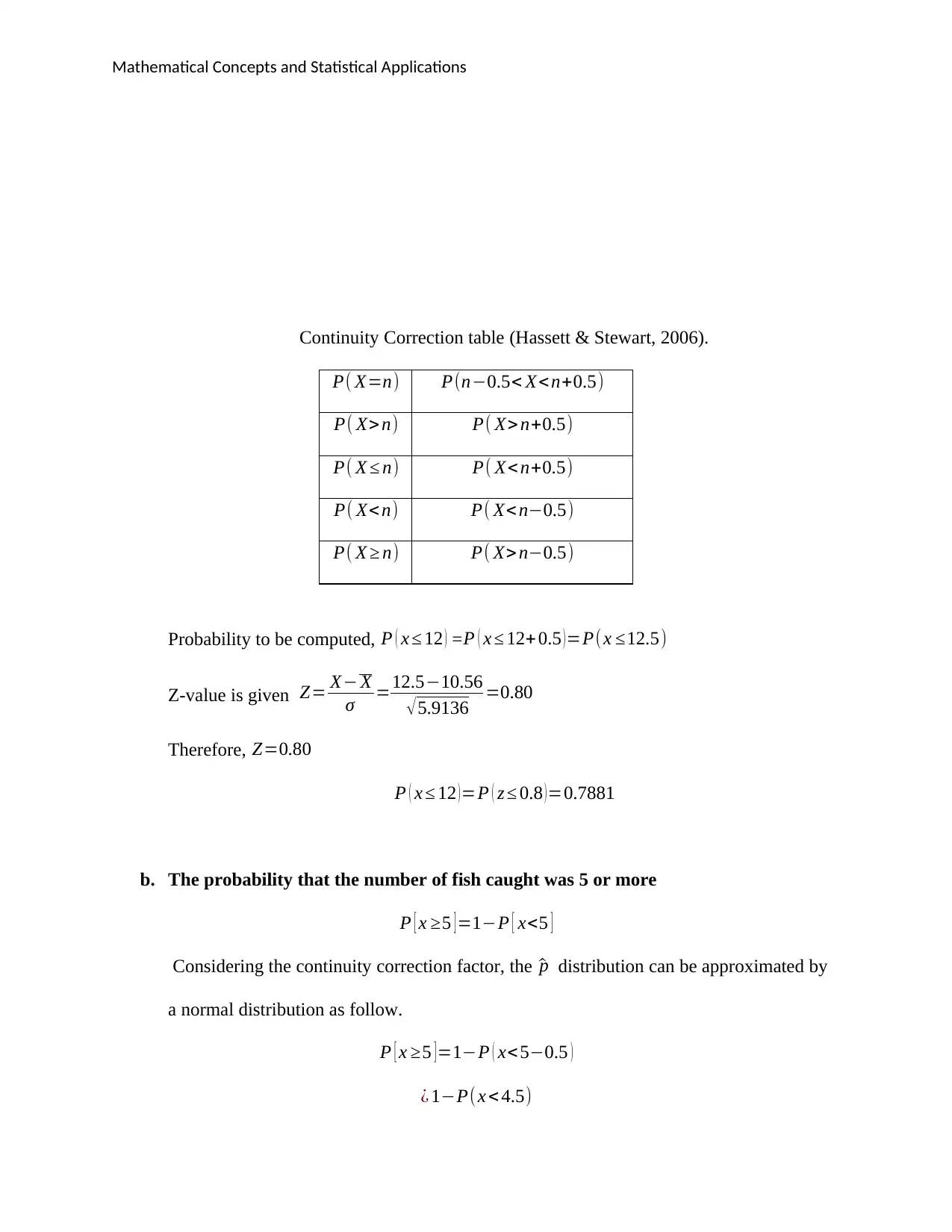
Mathematical Concepts and Statistical Applications
Continuity Correction table (Hassett & Stewart, 2006).
P( X=n) P(n−0.5< X< n+0.5)
P( X> n) P( X> n+0.5)
P( X ≤ n) P( X< n+0.5)
P( X< n) P( X< n−0.5)
P( X ≥ n) P( X> n−0.5)
Probability to be computed, P ( x ≤ 12 ) = P ( x ≤ 12+ 0.5 ) =P(x ≤12.5)
Z-value is given Z= X− X
σ =12.5−10.56
√5.9136 =0.80
Therefore, Z=0.80
P ( x ≤ 12 )=P ( z ≤ 0.8 )=0.7881
b. The probability that the number of fish caught was 5 or more
P [ x ≥5 ] =1−P [ x<5 ]
Considering the continuity correction factor, the ^p distribution can be approximated by
a normal distribution as follow.
P [ x ≥5 ]=1−P ( x<5−0.5 )
¿ 1−P(x < 4.5)
Continuity Correction table (Hassett & Stewart, 2006).
P( X=n) P(n−0.5< X< n+0.5)
P( X> n) P( X> n+0.5)
P( X ≤ n) P( X< n+0.5)
P( X< n) P( X< n−0.5)
P( X ≥ n) P( X> n−0.5)
Probability to be computed, P ( x ≤ 12 ) = P ( x ≤ 12+ 0.5 ) =P(x ≤12.5)
Z-value is given Z= X− X
σ =12.5−10.56
√5.9136 =0.80
Therefore, Z=0.80
P ( x ≤ 12 )=P ( z ≤ 0.8 )=0.7881
b. The probability that the number of fish caught was 5 or more
P [ x ≥5 ] =1−P [ x<5 ]
Considering the continuity correction factor, the ^p distribution can be approximated by
a normal distribution as follow.
P [ x ≥5 ]=1−P ( x<5−0.5 )
¿ 1−P(x < 4.5)
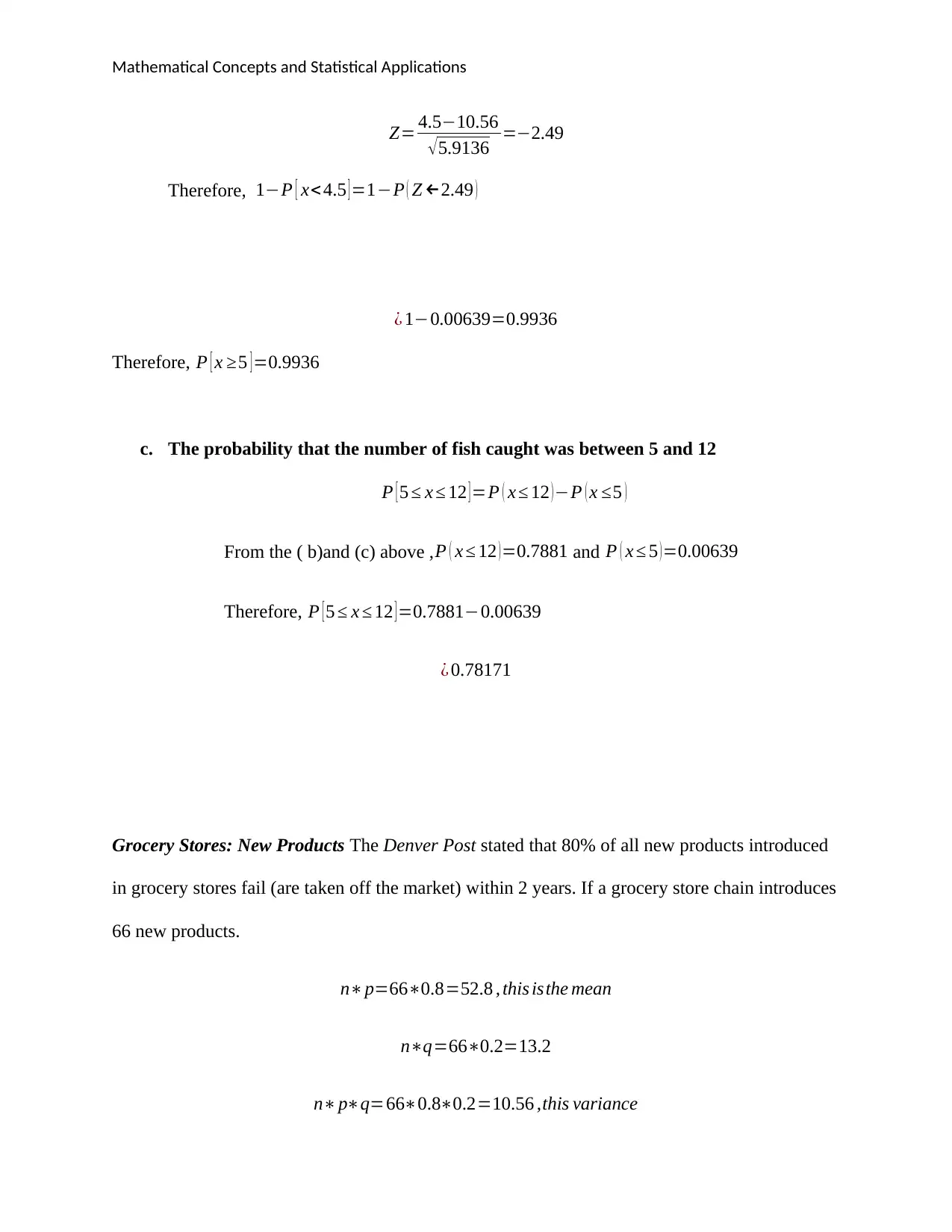
Mathematical Concepts and Statistical Applications
Z= 4.5−10.56
√5.9136 =−2.49
Therefore, 1−P [ x< 4.5 ] =1−P ( Z ←2.49 )
¿ 1−0.00639=0.9936
Therefore, P [ x ≥5 ]=0.9936
c. The probability that the number of fish caught was between 5 and 12
P [ 5 ≤ x ≤ 12 ] =P ( x ≤ 12 ) −P ( x ≤5 )
From the ( b)and (c) above , P ( x ≤ 12 ) =0.7881 and P ( x ≤ 5 ) =0.00639
Therefore, P [ 5 ≤ x ≤ 12 ] =0.7881−0.00639
¿ 0.78171
Grocery Stores: New Products The Denver Post stated that 80% of all new products introduced
in grocery stores fail (are taken off the market) within 2 years. If a grocery store chain introduces
66 new products.
n∗p=66∗0.8=52.8 , this isthe mean
n∗q=66∗0.2=13.2
n∗p∗q=66∗0.8∗0.2=10.56 ,this variance
Z= 4.5−10.56
√5.9136 =−2.49
Therefore, 1−P [ x< 4.5 ] =1−P ( Z ←2.49 )
¿ 1−0.00639=0.9936
Therefore, P [ x ≥5 ]=0.9936
c. The probability that the number of fish caught was between 5 and 12
P [ 5 ≤ x ≤ 12 ] =P ( x ≤ 12 ) −P ( x ≤5 )
From the ( b)and (c) above , P ( x ≤ 12 ) =0.7881 and P ( x ≤ 5 ) =0.00639
Therefore, P [ 5 ≤ x ≤ 12 ] =0.7881−0.00639
¿ 0.78171
Grocery Stores: New Products The Denver Post stated that 80% of all new products introduced
in grocery stores fail (are taken off the market) within 2 years. If a grocery store chain introduces
66 new products.
n∗p=66∗0.8=52.8 , this isthe mean
n∗q=66∗0.2=13.2
n∗p∗q=66∗0.8∗0.2=10.56 ,this variance
⊘ This is a preview!⊘
Do you want full access?
Subscribe today to unlock all pages.

Trusted by 1+ million students worldwide
1 out of 20
Related Documents
Your All-in-One AI-Powered Toolkit for Academic Success.
+13062052269
info@desklib.com
Available 24*7 on WhatsApp / Email
![[object Object]](/_next/static/media/star-bottom.7253800d.svg)
Unlock your academic potential
Copyright © 2020–2025 A2Z Services. All Rights Reserved. Developed and managed by ZUCOL.



